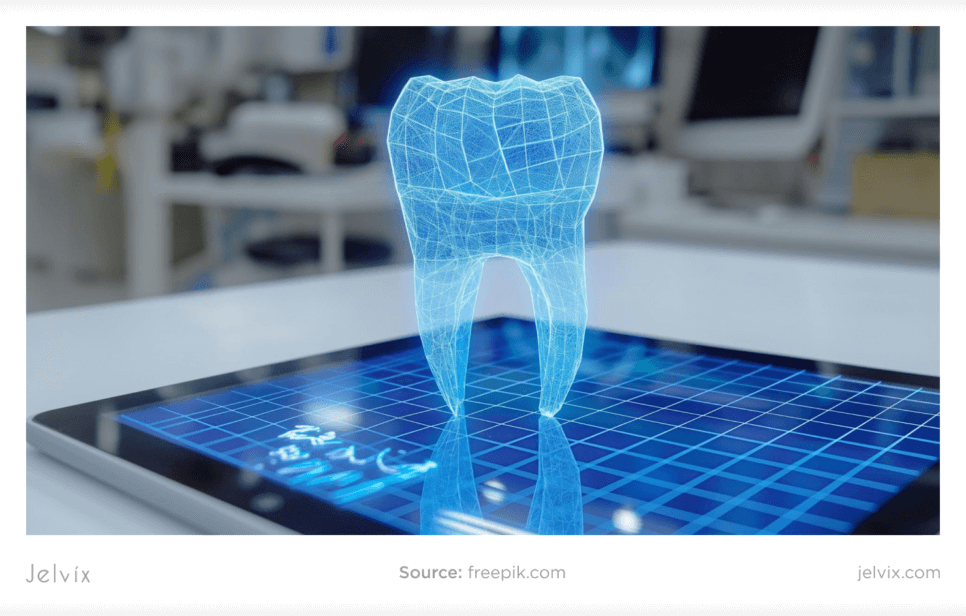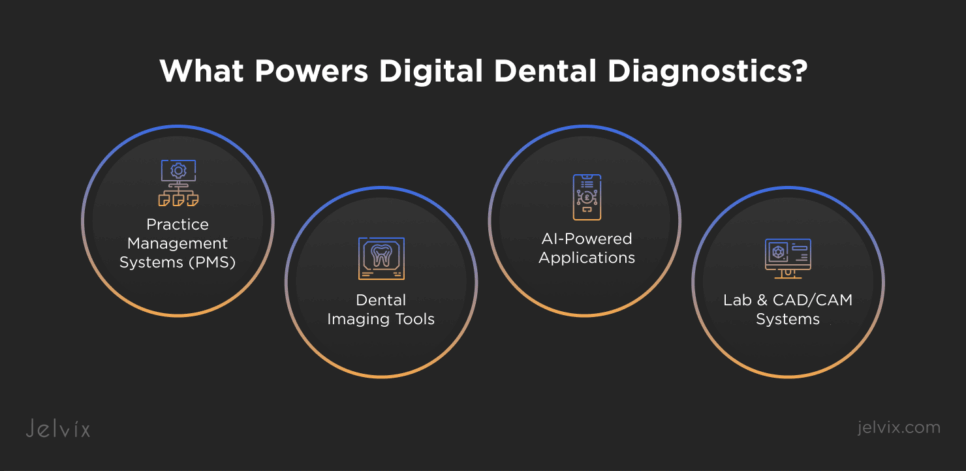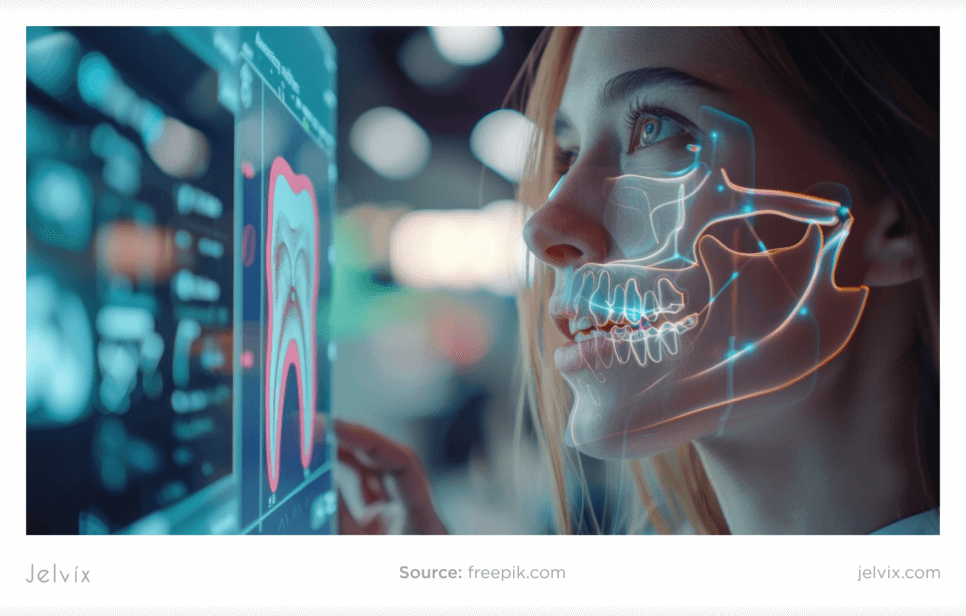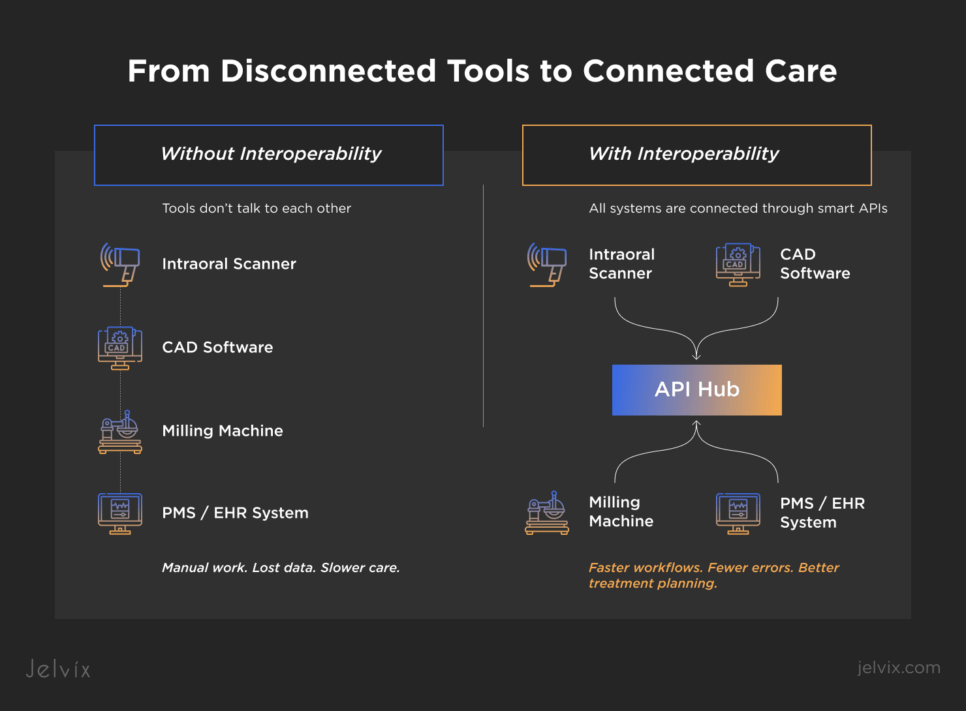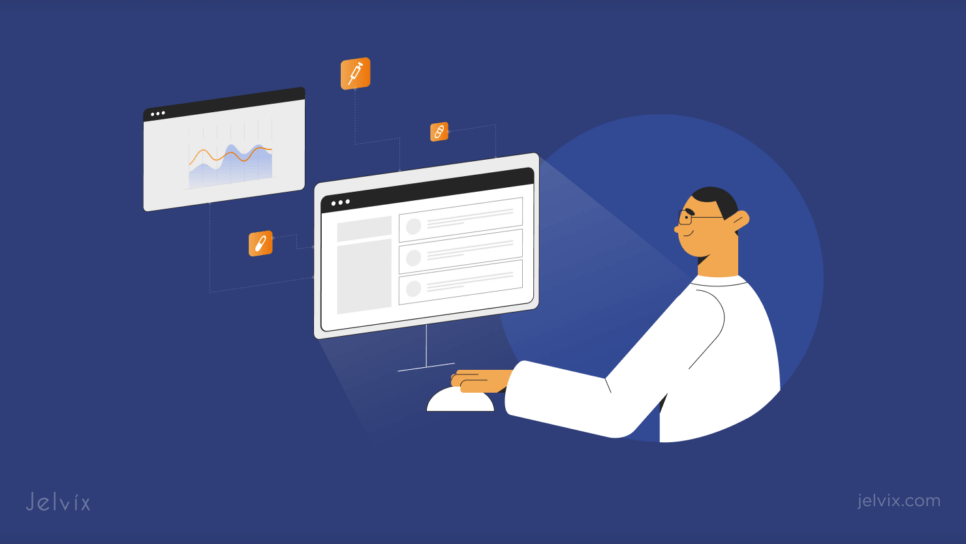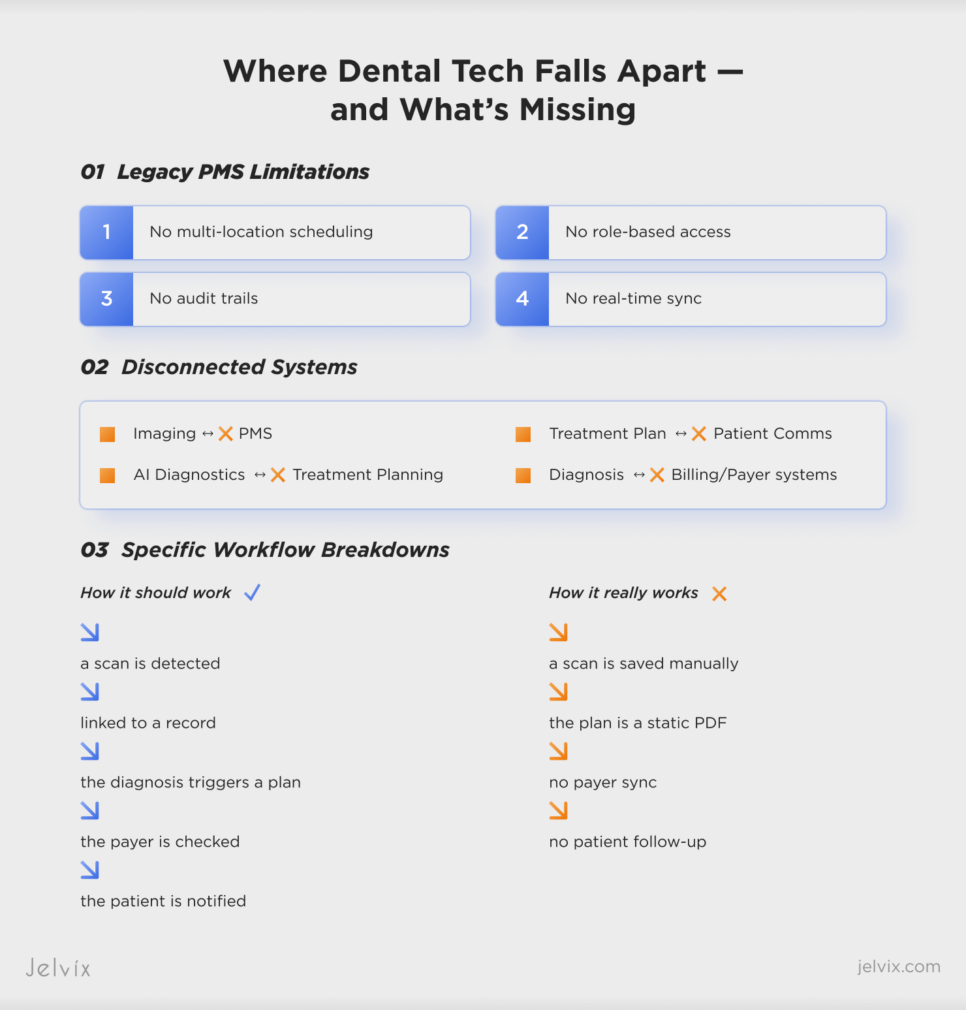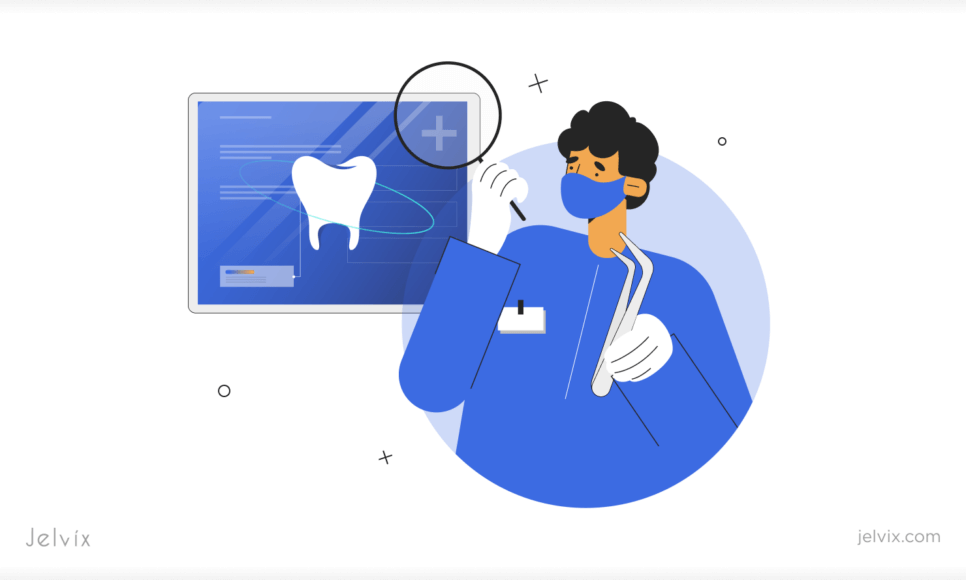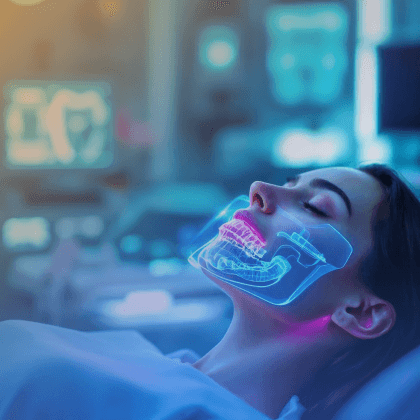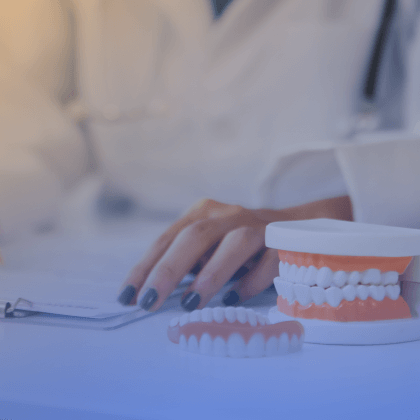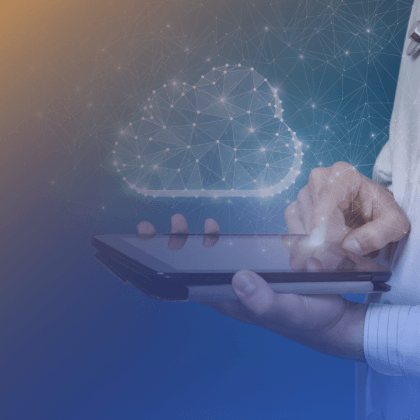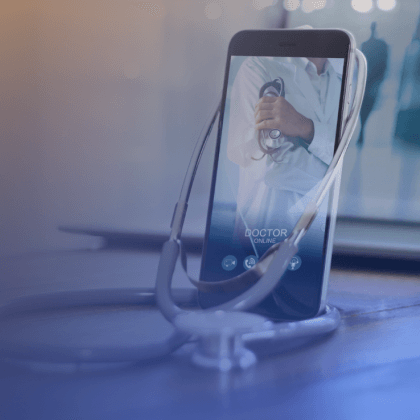Digital dentistry has evolved far beyond simply displaying 3D images on a chairside screen. Today the entire patient journey, from clinic visits to follow-up care, is reimagined and rebuilt through intelligent software.
As dental service organizations (DSOs) increase in scale and patient consumer habits harden around convenience and transparency, software vendors are compelled to transform. The transition from isolated diagnostic tools to comprehensive diagnostic and treatment platforms underpins why medical software development for dentistry is on the rise.
This article is for CPOs, CTOs, and product leaders at Dental SaaS companies navigating the shift toward scalable, intelligent platforms.
If you’re setting strategy around integration, clinical intelligence, or choosing between incremental upgrades and full-stack re-invention, the sections below break down where the digital density is, how to build around it, and what’s already redefining the competitive baseline.
Let’s dive into what matters most for staying ahead.
Why Digital Dentistry Is More Tnan Just 3D Scans
The gap between clinical needs and software capabilities is exactly what’s driving rapid change in dental software development. Legacy PMS tools fall short when it comes to enabling real-time collaboration, intelligent treatment planning, or seamless communication between clinics and labs.
Now, however, we see the emergence of a new breed of API-first, cloud-native platforms that are designed for more than just storing data; they are designed for data orchestration, integrating AI, and predictive modelling. That change isn’t just aesthetic, Dr. David Guichet points out; it’s financial. With better digital, you increase lab efficiency and chairside profitability.
The urgency is difficult to ignore. According to a study from Harrisburg University, the clinics already using digital systems have a higher patient satisfaction rate, and most using analog workflows are soon to go digital as well. The digital impression systems market, for example, is expected to command a CAGR of close to 20% up to 2026, and AI is rapidly speeding up case review and the diagnostic process, creating a growing chasm between the early adopters and the dilly-dallyers. Today, postponing integration is no longer a risk-neutral choice; it’s a risk to product-market fit.
The Core Tech Stack Behind Modern Digital Dental Care
Dental diagnostics today depend on more than clinical skill or precision instruments; they hinge on a fragmented constellation of digital systems. Practice management systems (PMS), dental imaging solutions, AI-powered diagnostic engines, and CAD/CAM lab software each form critical links in the care chain, yet operate as isolated modules. There is one fundamental issue for systems designed by different vendors that are often built on incompatible technical stacks: they do not interoperate.
PMS Platforms and Imaging Dental Technology
Most of today’s PMS platforms still rely on legacy database schemas and monolithic architectures with limited extensibility. Their APIs, if they exist at all, are often undocumented, outdated, or locked up in costly vendor agreements.
Imaging software, meanwhile, outputs large volumes of high-resolution DICOM data, but only a few systems contain real-time DICOM parsing and rendering pipelines that can be integrated with patients’ live records. Instead, files are exported manually, renamed, and uploaded into PMS folders, creating operational friction and opportunity for human error.
AI Diagnostic Dental Applications
AI diagnostic engines, including caries detection, nerve mapping, and radiograph classifiers, typically operate as cloud-hosted inference models. However, their deployment into clinical workflows is hamstrung by poor integration. Some tools require manual image uploads to web portals. Others use brittle desktop applets that break when local file structures change. Without event-driven APIs or standardized HL7/FHIR compatibility layers, these tools remain detached from the care delivery pipeline, unable to feed insights directly into treatment planning logic.
Explore how AI is transforming medical billing by reducing errors, accelerating reimbursements, and improving revenue cycle efficiency for healthcare providers.
Lab Systems
On the lab side, digital impressions from intraoral scanners are increasingly passed as STL or PLY files, but downstream applications often lack support for automated mesh validation, model segmentation, or material constraint encoding. Dentists and lab technicians are left navigating shared drives or third-party portals, which delay the fabrication process and erode standardization.
The fundamental problem is architectural: none of these systems is designed for horizontal scalability, synchronous communication, or zero-trust data exchange. Many suppliers, when developing the interoperability module, don’t even regard it as a basic principle of design. For modern DSOs handling dozens or hundreds of clinics, a lack of clinical interoperability means work collapses due to load volume, data becomes siloed, and critical diagnoses are left inaccessible at the point of care.
Dental imaging solutions and AI must be embedded, not adjacent. RESTful APIs, real-time message buses, and unified data layers using FHIR or GraphQL interfaces are their foundational elements. Middleware should handle data normalization and orchestration, so that any update triggers contextual updates across the entire system.
Diagnostic-Driven Innovation: Where AI and Imaging Add Real Value
The true differentiator in modern digital dental systems isn’t the presence of AI. It’s the precision of its implementation. Many vendors in the AI dental space now provide radiograph interpretation, caries detection, bone loss quantification, and periodontal analysis tools. These systems leverage convolutional neural networks (CNNs), trained on millions of annotated images, to identify pathology with high sensitivity and specificity.
The value of dental artificial intelligence only emerges when it becomes invisible to the end user, woven into the diagnostic narrative, not tacked onto it. For example, detecting carious lesions is not meaningful if the clinician has to exit their imaging viewer, log into a third-party portal, upload the scan, wait for processing, and manually transfer outputs back into the patient’s chart.
That’s not augmented intelligence; that’s workflow decay. Instead, high-performing systems deliver results directly into the PMS interface, overlay AI findings on top of radiographs inside the imaging viewer, and synchronize diagnostic flags with treatment planning modules.
Modern dental imaging systems must support this fluidity. Static viewers are insufficient; clinicians expect real-time rendering, AI annotations that update live with image enhancements, and access to multi-layered visualizations all inside a single frame. This requires imaging SDKs that can interpret DICOM, JPEG2000, and proprietary CBCT formats in-memory, without introducing latency or compression artifacts.
From a product architecture standpoint, integrating AI and imaging into dental workflows requires more than just adding APIs. It means building UI elements and user journeys around diagnostic moments. Smart hover states, auto-labeled callouts, and clickable pathology markers turn radiographs into interactive decision tools. Backend logic should support confidence scoring, multi-model ensemble voting, and explainability layers, so clinicians understand not only what the AI detected but also why it reached that conclusion.
This is why DSOs are choosing smarter dental platforms: platforms that surface diagnostic insights precisely where users need them, reduce inter-app toggling, and support collaborative care across multiple specialties and locations. Whether it’s a restorative dentist reading an AI-assisted scan or an orthodontist aligning treatment plans with AI-mapped anatomical landmarks, the system must act as both assistant and synchronizer.
Interoperability Is the Missing Link in Digital Dentstry
Disconnected Tools, Disrupted Workflows
The evolution of digital dental systems has brought CAD/CAM, 3D printing, and chairside milling to the forefront of treatment delivery. Although these tools speed restorations and tailor care, their efficacy is squelched by how poorly they interact. What may appear to be a smooth digital workflow in a demo can end up as a manual patchwork in real-world clinics.
STL files exported from intraoral scanners may not be pre-cleaned or named correctly; the design phase is disconnected, often taking place in siloed software, with no automated checkpoints; and even when a crown is milled chairside, the attendant metadata might never reattach to the patient’s digital record. The result: disconnected outputs, clinical overhead, and fragile processes.
This disconnection is about messaging. And again, most hardware is built on a closed protocol or a proprietary interface. Downstream tools can’t query or validate upstream logic because there are no translation layers or middleware. Dental teams are left to fill in the gaps with spreadsheets, emails, or worse, manual transcription. The illusion of seamless dentistry is broken not by lack of digitization, but by lack of coherence.
APIs as Infrastructure
To vendors, building API-first dental software is no longer a goal—rather, it’s a requirement. For DSOs with hundreds of locations, rapid onboarding is essential, but they also need to integrate their imaging and lab stacks into this new software. And they must have the flexibility of using other tools if they so choose, without getting locked into any one vendor’s system. These demands simply can’t be met by large and unwieldy systems. What’s necessary are computer networks that provide stable schemas for publishing data, bi-directional data flow, along with security and control.
Learn how API integration is streamlining healthcare systems, enabling secure data exchange, improving patient care, and powering digital transformation in the industry.
What separates fast-moving vendors from legacy-bound competitors is their orientation toward infrastructure. Smart teams invest early in event-driven backends, GraphQL abstraction layers, and schema registries that can evolve without breaking downstream consumers. Teams that embrace this discipline treat interoperability as a growth multiplier, not a technical debt item. That’s the mindset behind sustainable SaaS software development: designing for fluid data, distributed logic, and scalable care delivery.
How Market Forces Are Accelerating Digital Dentistry Adoption
Digital Dentistry Adoption Is No Longer Optional for DSOs
The digital dentistry market is accelerating not because technology is new, but because inefficiencies in analog workflows have become untenable. Digital systems now support AI-driven diagnostics, chairside planning, cloud-based imaging retrieval, and seamless file transfer to labs. And the gains are measurable.
For single-unit restorations, digital workflows reduce active working time by 38.4%, and total treatment time drops by more than 60% as mentioned in research done by Dr. Namrata Upadhyay.
Bite registration time alone is cut by 60.4%, and lab turnaround shrinks from two weeks to just days, a 75–85% improvement, according to findings in NLM.
At the operational level, dental labs can save 70–80% in cost per part by replacing manual fabrication with CAD/CAM pipelines.
Labor cost reductions of up to 30% and workflow capacity increases nearing 50% make the return on investment increasingly favorable, as stated by Rolan Berger.
This shift toward digital is architectural. DSOs now demand software that integrates imaging, planning, and records with minimal human middleware. Vendors capable of exposing diagnostic events via API dental endpoints and orchestrating cloud-first workflows are dominating RFP shortlists. Real growth now depends on composability and data liquidity. As DSOs scale, they want platforms that behave like infrastructure.
That’s why leaders are investing in horizontally scalable, cloud-native backends. Medical cloud computing enables instant access to patient files, imaging archives, and live diagnostics, not only from other locations but also from different systems altogether. Digital dentistry platforms that support real-time, API-driven interoperability across sites are already outpacing analog-first competitors in implementation speed and long-term clinic satisfaction.
Patients Are Choosing Experiences, Not Just Treatments
Patients nowadays won’t put up with outdated workflows. With digital impressions, you can avoid the discomfort of messy impressions, and chair time is significantly shortened, as dimensional verification is therefore reduced. That’s not just a few isolated facts: 89% of patients want a digital experience, and only 11% would like things done in the traditional way.
But these are not only convenience factors; from a clinical standpoint, they can also increase acceptance of cases, reduce anxiety, and improve satisfaction with care. When patients can view their scans on a tablet, see a clear graphical representation of each procedure to be performed, and understand the reasons behind the recommendations from a single interface, trust naturally increases. The final result might be exactly the same, but the journey there is a whole lot better.
In clinical terms, digital workflows not only maintain quality but frequently surpass what can be achieved by manual methods. Studies have shown that restorations created via digital workflows consistently maintain a much better interproximal and occlusal contact than those made using the traditional approach. And while marginal fit statistically still matches this too, the higher success rate of digital is 53.3% compared with 46.7% for manual, suggesting that there is lower downstream variability in lab performance.
Gaps in Dental Technology Infrastructure
Legacy PMS tools actively calcified around operational blind spots. Features like multi-location scheduling, role-based access for mobile teams, audit trails across providers, and real-time syncing across devices are either missing or bolted on via unreliable plugins.
Even basic capabilities like cross-location reporting or patient identity resolution across clinic groups are absent in many systems still claiming to be enterprise-grade. Simply put, these platforms weren’t built as scalable tech stacks for multi-location dental groups, and retrofitting them rarely works.
The modern dental workflow relies on interoperability between diagnostic inputs, planning systems, financial logic, and patient engagement. But even the most “modern” dental SaaS offerings often fall short on actual integration. Imaging systems are sometimes bolted on without bi-directional data flow. AI diagnosis modules can’t push structured findings into the treatment plan layer. Treatment plans don’t always interface with patient communication systems or payer authorization tools.
Take imaging as a baseline. Many tools support intraoral scanners but do not provide contextual data persistence; no versioning, no annotations saved to record, and no structured export of findings. AI modules that detect pathologies on radiographs may surface insights, but without embedded endpoints into PMS or scheduling software, they fail to influence the actual treatment trajectory. Plans remain static PDFs instead of living, editable workflows. Even billing is disconnected: a confirmed diagnosis may not trigger a payer eligibility check or authorization request because the systems remain siloed.
In this environment, dental technology loses its edge. Instead of streamlining care, it fragments it. What’s needed is platform-level intelligence: systems that recognize when a scan is captured, tie it to a treatment plan, flag next steps using AI, check payer data, and prompt patient messaging, without any manual coordination.
From Monoliths to Modular: The Platform Shift in Dental SaaS
Market leaders are consolidating fragmented workflows into unified experiences or decomposing monoliths into modular, API-exposed services. Both directions reflect one priority: adaptability.
The most successful vendors are now building for infrastructure-grade use cases: real-time data sync across imaging, scheduling, and treatment plans; embedded diagnostics; cross-clinic coordination; and analytics layers that surface operational bottlenecks without the need for manual exports.
This shift explains the growing emphasis on API dental architecture. Leading platforms now default to exposing endpoints for everything from patient onboarding to AI scoring logic, lab job status, and payer eligibility checks. Go-to-market teams are also shifting away from one-size-fits-all packages. Instead, they offer digital dentistry software as white-labeled modules for DSOs and OEMs or deliver tailored mobile-first tools designed around specific workflows, from scan-to-quote or scan-to-schedule, all the way through post-treatment follow-ups.
From a clinical value perspective, this trend is tightly linked to outcomes. Vendors who understand how digital dentistry improves diagnosis and treatment are hardwiring their products to deliver more than speed. They enable more consistent care pathways, reduce diagnostic ambiguity, and allow clinicians to make decisions with greater confidence and visual clarity. This is especially visible in systems that combine imaging interpretation with real-time case planning and automatic risk flagging.
Modularity and composability also allow vendors to adapt without burning cycles on custom dev. Want to layer on an AI vendor’s radiograph analysis? Just connect their prediction engine through an existing webhook. Need a new UI for orthodontic workflows? Spin up a mobile-first frontend that consumes the same GraphQL layer as general dentistry modules. The result is a stack that scales not just with users, but with market complexity.
Alignment for the Best Dental Software
One critical axis is data liquidity. If your platform can’t extract value from diagnostic scans, keep planning updates synchronized in real time, or send structured case data to labs and payers, then it isn’t a platform, it’s just a collection of tools. Teams should be asking themselves where they can insert meaningful inflection points with embedded intelligence: whether that’s event-driven analytics, real-time API callbacks, or pre-authorization logic wired into treatment planning workflows.
Another axis is standards compliance. As multi-vendor ecosystems become the norm, adherence to the FHIR interoperability standard isn’t optional. Vendors that natively support FHIR-based resources for imaging, patient data, scheduling, and diagnostics gain faster integration timelines, lower onboarding costs, and reduced vendor lock-in for clients.
Partnership strategy also matters. The fastest-growing platforms don’t build everything internally; they curate intelligently. Whether it’s an AI partner for radiograph interpretation, a payer integration for checking eligibility before doing work, or a preferred lab platform. The thinking is: build where differentiation is essential, integrate where the need for velocity and scale is overwhelming. This only works if the architecture is composable and API-native from the start.
For product leaders, the challenge is balancing modularity with narrative. You need to offer discrete components without fragmenting the user journey. That means building not just individual features, but the connective tissue between them. And doing it with an eye toward clinical flow, operational scale, and data governance.
Conclusion: The Digital Dentistry Advantage
Features don’t win anymore. Full workflow ownership does.
Digital dentistry isn’t about adding flashy tools — it’s about connecting diagnosis, treatment, imaging, planning, and patient engagement into one intelligent, scalable system. The platforms leading today act less like products and more like infrastructure.
If you’re a product leader feeling boxed in by legacy stacks, disconnected tools, or stalled rollouts, it’s time to think bigger.
Jelvix partners with CPOs and CTOs to move beyond incremental fixes — building scalable, API-first systems that tackle clinical complexity and unlock enterprise growth.
Talk to the Jelvix experts about building infrastructure that your customers demand — and your competitors haven’t even started.
Looking to scale with top talent?
Boost your development capacity with a dedicated team of experienced professionals.


